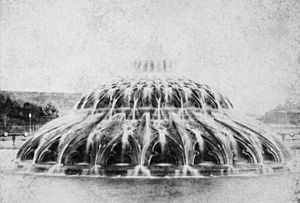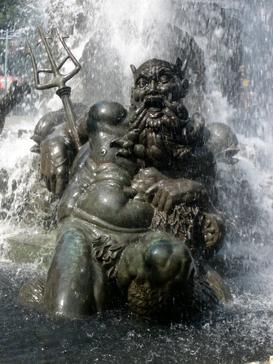Bailey Fountain facts for kids
Quick facts for kids Bailey Fountain |
|
|---|---|
| Artist | Egerton Swartwout (architect) Eugene Savage (sculptor) |
| Completion date | 1929-1932 |
| Medium | Fountain |
| Location | Prospect Park, Brooklyn, New York City |
| 40°40′26″N 73°58′12″W / 40.67389°N 73.97009°W | |
The Bailey Fountain is a beautiful outdoor fountain in Grand Army Plaza in Brooklyn, New York City. It stands where three older fountains once were. This fountain was finished in 1932.
A kind person named Frank Bailey paid for it. He wanted it to be a special way to remember his wife. The fountain has been fixed up a few times, in 1956 and again in 2005-2006. Some parts of the sculptures were even stored away safely after they were stolen in 1974.
Contents
What is Bailey Fountain?
The Bailey Fountain is a large and impressive water feature. It is located in a famous part of Brooklyn called Grand Army Plaza. This area is a gateway to Prospect Park.
The fountain is known for its detailed sculptures. These sculptures were created by Eugene Savage. The overall design was by architect Egerton Swartwout.
Early Fountains at Grand Army Plaza
Before the Bailey Fountain, Grand Army Plaza had other fountains. Each one was different and had its own story. Let's explore the fountains that came before it.
The First Fountain: Golden Spray
The very first fountain was called the Fountain of the Golden Spray. It was built in 1867. This fountain was simple, with just one jet of water shooting up. It was part of the original design for Grand Army Plaza.
The Dome Fountain
In 1873, a new fountain replaced the Golden Spray. This one was designed by Calvert Vaux. It was a two-story structure with two domes. It was made from cast iron and a special type of concrete called Beton Coignet.
This dome fountain was quite fancy for its time. It had gaslights inside its 37.2-foot (11.4 m) wide dome. These lights shone through 24 colored glass windows. This made the fountain glow at night! More gaslights around the edge lit up the water.
However, the fountain used a lot of water. It could pump 60,000 gallons every hour. The mayor of Brooklyn even complained about how much water it used. By the 1890s, the fountain often leaked and was dry.
The Amazing Electric Fountain
The Electric Fountain was built in 1897. It replaced the leaky dome fountain. This new fountain was very exciting because it used electricity! It was controlled by two people. They put on amazing water and light shows on Wednesday and Saturday nights. Up to 30,000 people would come to watch.
A man named Fredric W. Darlington designed this special fountain. It was placed in the center of the plaza. The first big show was on August 7, 1897. About 100,000 people came to see it!
How the Electric Fountain Worked
The Electric Fountain used powerful lights. These lights could be dimmed or made brighter. They could also be moved to make the light beams wider or narrower. The lights shone through colored glass disks. This made the water jets appear in different colors.
There were about 2,000 nozzles in the fountain. These nozzles created all sorts of water shapes. Some looked like umbrellas, balls, or fans. There was even a central geyser, which is a big spout of water.
The people controlling the fountain worked in an underground room. They could see the pool through special windows. A pump recycled up to 100,000 gallons of water per hour. The fountain also had many smaller lights around its edge. Local railroad companies even donated the electricity for the shows.
Why the Electric Fountain Was Removed
The Electric Fountain was a big hit, but it didn't last forever. In 1915, new subway lines were built under Grand Army Plaza. There wasn't enough space for the fountain's complex machinery anymore. So, the Electric Fountain had to be removed.
See also
 In Spanish: Fuente Bailey para niños
In Spanish: Fuente Bailey para niños



